tow CADILLAC DEVILLE 1998 7.G Service Manual
[x] Cancel search | Manufacturer: CADILLAC, Model Year: 1998, Model line: DEVILLE, Model: CADILLAC DEVILLE 1998 7.GPages: 386, PDF Size: 22.36 MB
Page 279 of 386

Downloaded from www.Manualslib.com manuals search engine 6. Remove any rust or dirt
from the wheel bolts,
mounting
surfaces and
spare wheel.
-
Rust or dirt on the wheel, or on the parts to
which
it is fastened, can make the wheel nuts
become loose after
a time. The wheel could come
off and cause an accident. When you change
a
wheel, remove any rust or dirt from the places
where the wheel attaches to the vehicle. In an
emergency, you can use
a cloth or a paper towel
to do this;
but be sure to use a scraper or wire
brush later,
if you need to, to get all the rust or
dirt off.
A CAJTION:
Never use oil or grease on studs or nuts. If you
do, the nuts might come loose. Your wheel could
fall
off, causing a serious accident.
7. Replace the wheel nuts
with the rounded end
of
the nuts toward the
wheel. Tighten each nut
5-30
Page 285 of 386
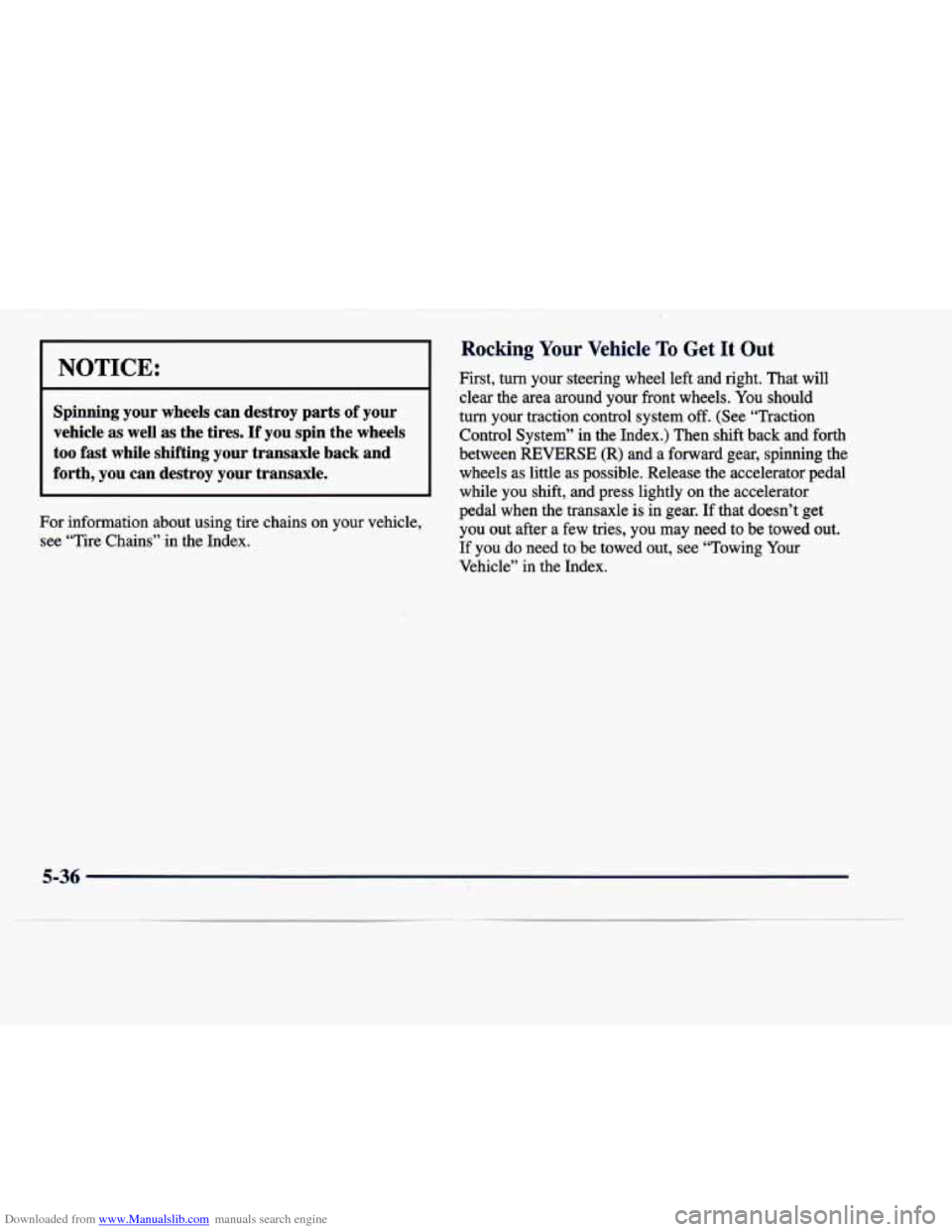
Downloaded from www.Manualslib.com manuals search engine NOTICE:
Spinning your wheels can destroy parts of your
vehicle as well as the tires. If you spin the wheels
too fast while shifting your transaxle back and
forth, you can destroy your transaxle.
For information about using tire chains on your vehicle,
see “Tire Chains” in the Index.
Rocking Your Vehicle To Get It Out
First, turn your steering wheel left and right. That will
clear the area around your front wheels.
You should
turn your traction control system
off. (See “Traction
Control System” in the Index.) Then shift back and forth
between
REVERSE (R) and a forward gear, spinning the
wheels as little as possible. Release the accelerator pedal
while you shift, and press lightly on the accelerator
pedal when the transaxle is in gear. If that doesn’t get
you out after a few tries, you may need to be towed out.
If you do need to be towed out, see “Towing Your
Vehicle” in the Index.
5-36
Page 299 of 386
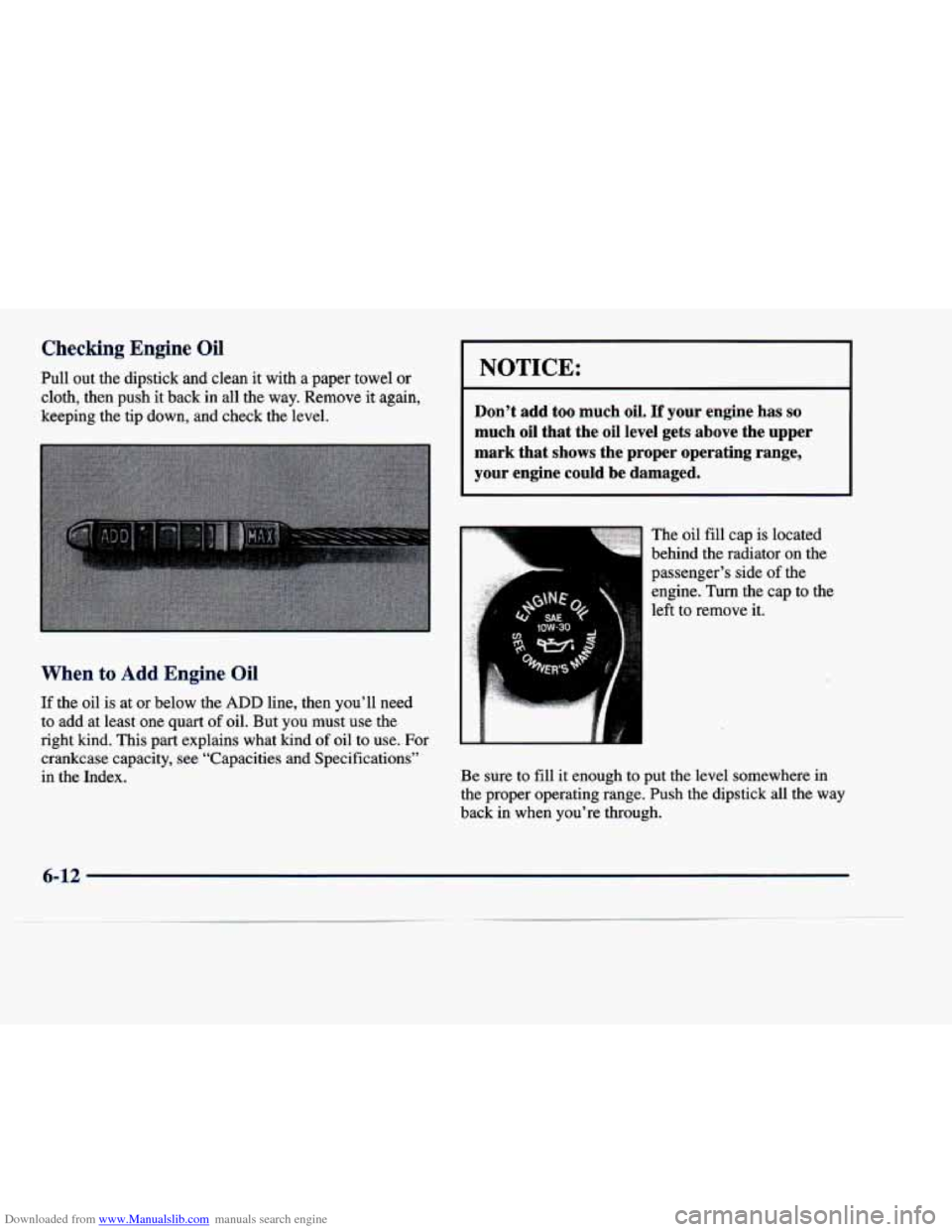
Downloaded from www.Manualslib.com manuals search engine Checking Engine Oil
Pull out the dipstick and clean it with a paper towel or
cloth, then push it back in all the way. Remove it again,
keeping the tip down, and check the level.
When to Add Engine Oil
If the oil is at or below the ADD line, then you’ll need
to add at least one quart of oil. But you must use the
right kind. This part explains what kind
of oil to use. For
crankcase capacity, see “Capacities and Specifications”
in the Index.
I NOTICE:
Don’t add too much oil. If your engine has so
much oil that the oil level gets above the upper
mark that shows the proper operating range,
your engine could be damaged.
The oil fill cap is located
behind the radiator on the
passenger’s side of the
engine.
Turn the cap to the
left to remove it.
Be sure to fill
it enough to put the level somewhere in
the proper operating range. Push the dipstick all the way
back in when you’re through.
6-12
Page 303 of 386

Downloaded from www.Manualslib.com manuals search engine 1. Disconnect the Intake
Air Temperature (IAT)
sensor from the base of
the air cleaner.
2. With a screwdriver,
loosen the air duct
clamp, which is located at the mass airflow
sensor end of the
air duct.
L
4. Unhook both air cleaner cover latches. One latch is
located near the radiator hose (not shown) and the
other latch-is located next to the
UT sensor.
5. Pivot the air cleaner and air duct assembly toward
the front of the vehicle. Remove the cover.
3. Disconnect the air duct from the mass aifflow sensor.
6-16
Page 305 of 386
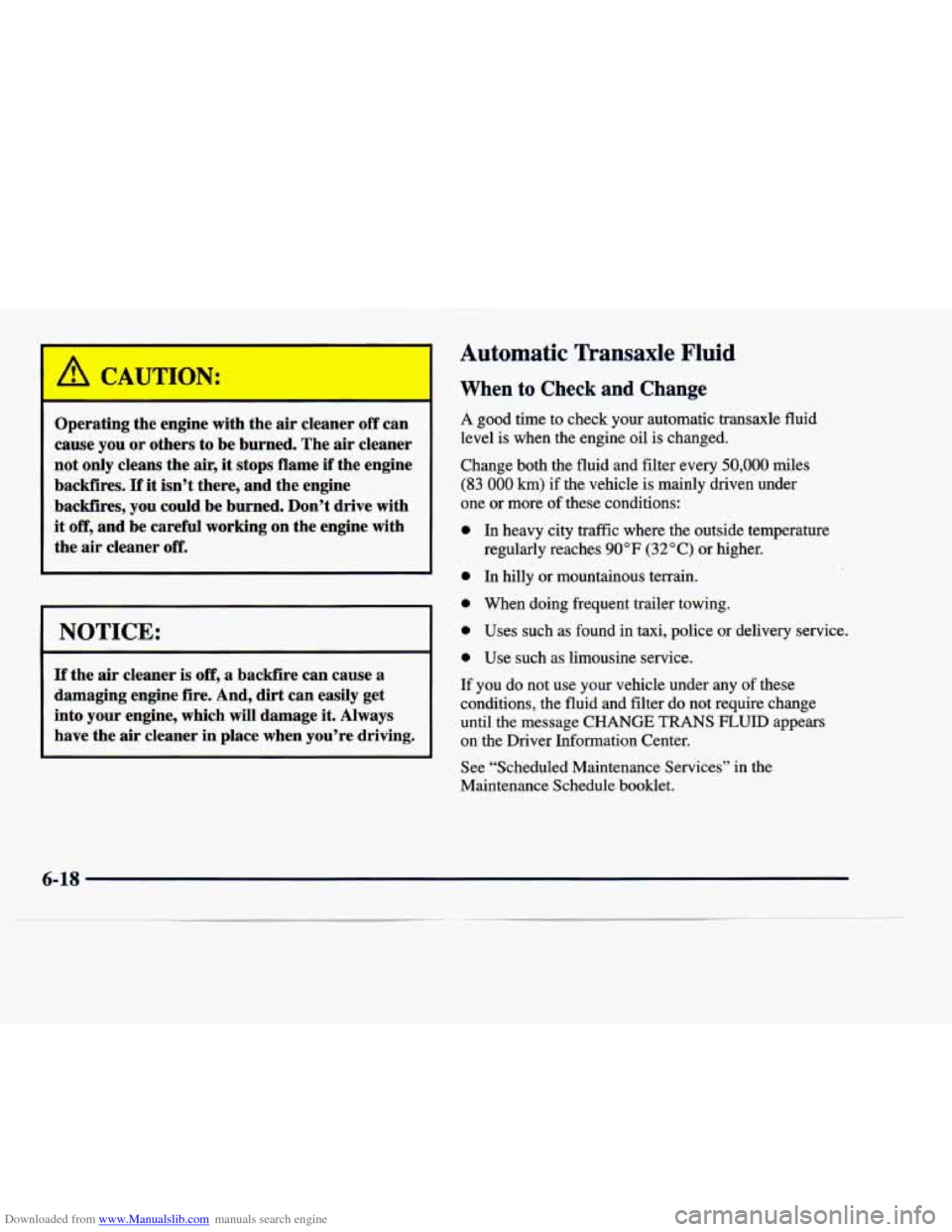
Downloaded from www.Manualslib.com manuals search engine Automatic Transaxle Fluid
Operating the engine with the air cleaner off can
cause you or others to be burned, The air cleaner
not only cleans the air, it stops flame if the engine
backfires.
If it isn’t there, and the engine
backfires, you could be burned, Don’t drive with
it
off, and be careful working on the engine with
the air cleaner
off.
NOTICE:
If the air cleaner is off, a backfke can cause a
damaging engine fire. And, dirt can easily get
into your engine, which will damage it. Always
have the air cleaner in place when you’re driving.
When to Check and Change
A good time to check your automatic transaxle fluid
level is when the engine oil is changed.
Change both the fluid and filter every
50,000 miles
(83 000 km) if the vehicle is mainly driven under
one or more of these conditions:
0 In heavy city traffic where the outside temperature
0 In hilly or mountainous terrain. regularly reaches
90°F (32°C) or higher.
0 When doing frequent trailer towing.
0 Uses such as found in taxi, police or delivery service.
0 Use such as limousine service.
If you do not use your vehicle under any of these
conditions, the fluid and filter do not require change
until
the message CHANGE TRANS FLUID appears
on the Driver Information Center.
See “Scheduled Maintenance Services” in the
Maintenance Schedule booklet.
6-18
Page 307 of 386
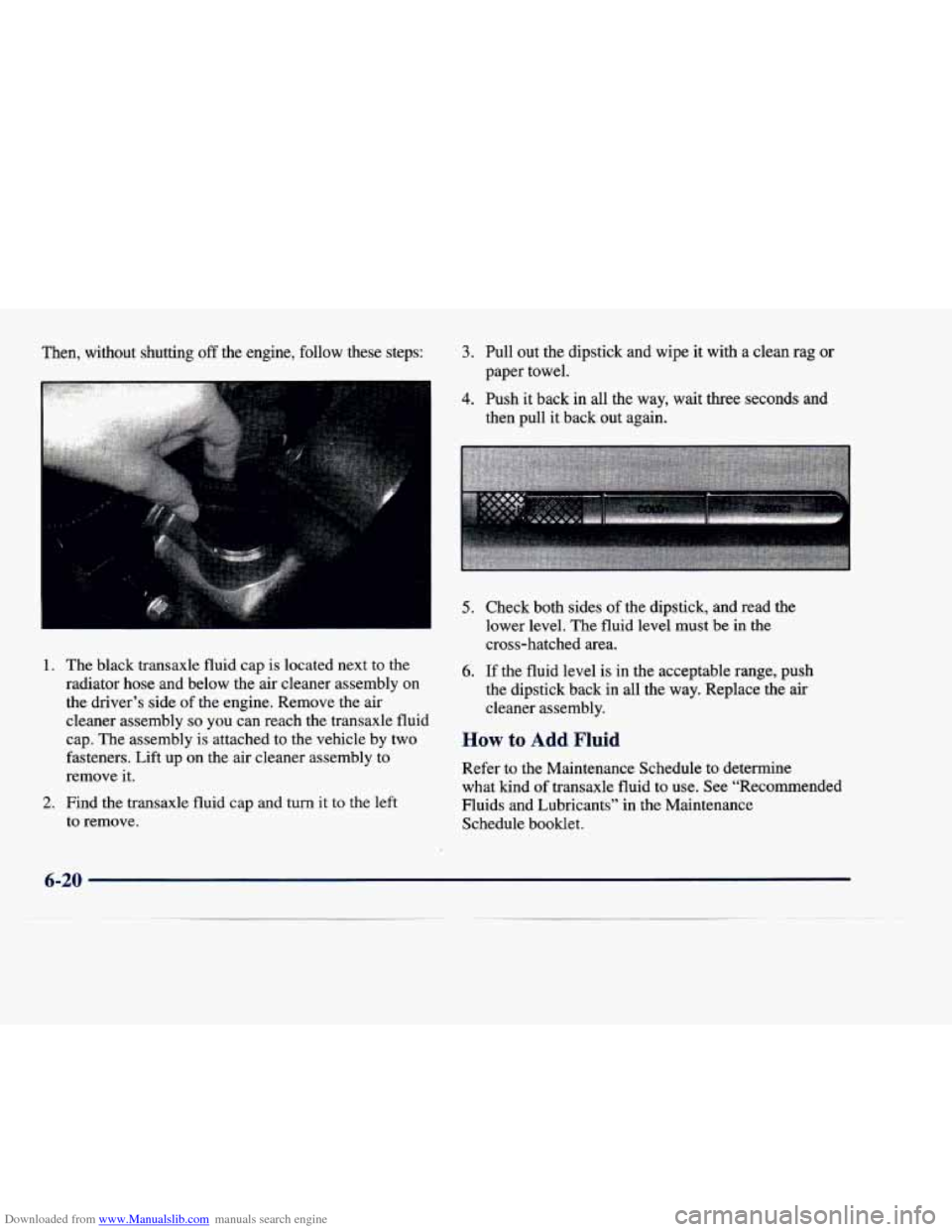
Downloaded from www.Manualslib.com manuals search engine Then, without shutting off the engine, follow these steps:
I
1. The black transaxle fluid cap is located next to the
radiator hose and below the air cleaner assembly on
the driver’s side of the engine. Remove the air
cleaner assembly
so you can reach the transaxle fluid
cap. The assembly
is attached to the vehicle by two
fasteners. Lift up on the air cleaner assembly to
remove it.
2. Find the transaxle fluid cap and turn it to the left
to remove.
3. Pull out the dipstick and wipe it with a clean rag or
4. Push it back in all the way, wait three seconds and
paper towel.
then pull it back out again.
5. Check both sides of the dipstick, and read the
lower level. The fluid level must be in the
cross-hatched area.
6. If the fluid level is in the acceptable range, push
the dipstick back in all the way. Replace the
air
cleaner assembly.
How to Add Fluid
Refer to the Maintenance Schedule to determine
what kind of transaxle fluid to use. See “Recommended
Fluids and Lubricants” in the Maintenance
Schedule booklet.
6-20
Page 330 of 386
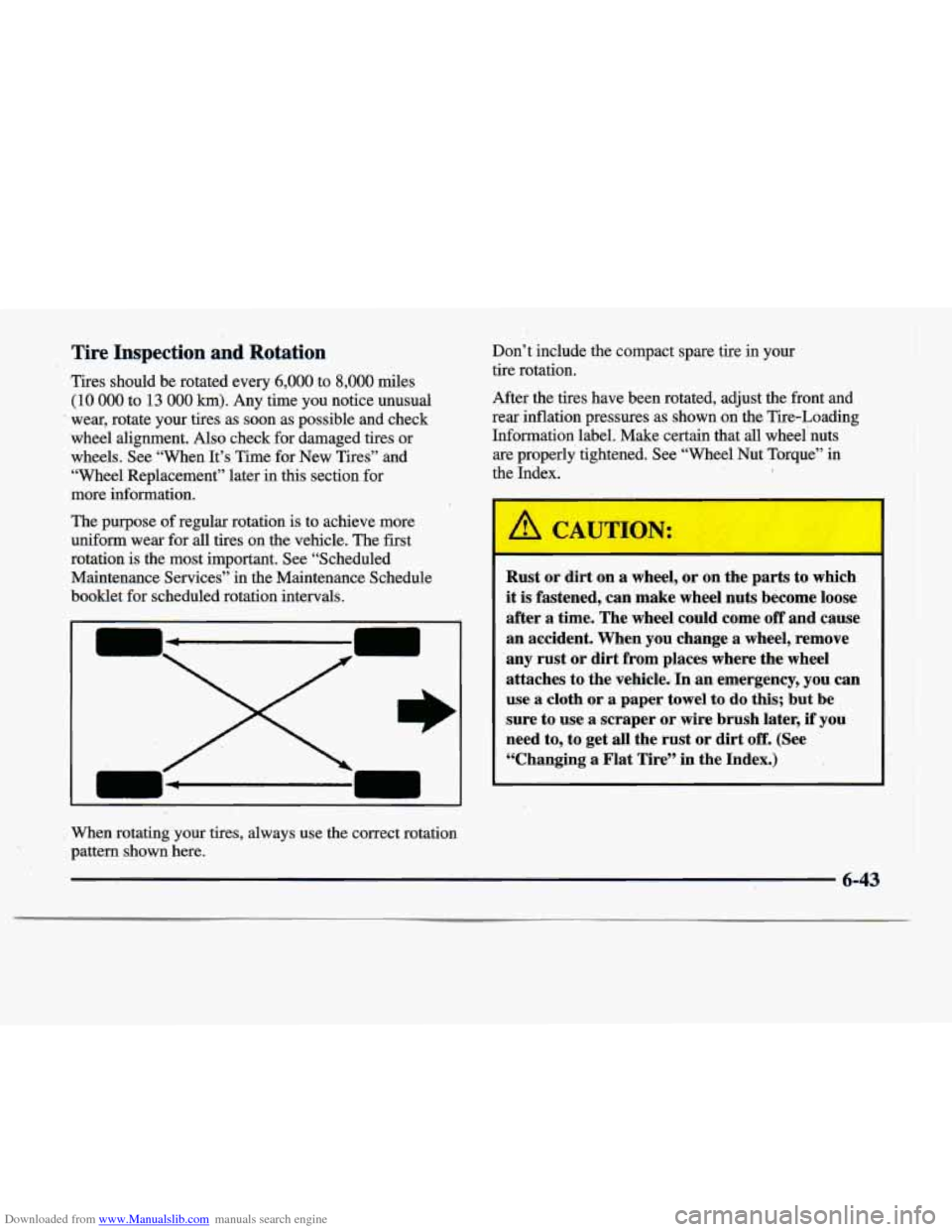
Downloaded from www.Manualslib.com manuals search engine Tire Inspection and Rotation
Tires should be rotated every 6,000 to 8,000 rriiles
(10 000 to 13 000 krn). Any time you notice unusual
. wear, rotate your tires as soon as possible and check
wheel alignment.
Also check for damaged tires or
wheels. See “When It’s Time for New Tires” and
“Wheel Replacement” later
in this section for
more information.
The purpose of regular rotation
is to achieve more
uniform wear for
all tires on the vehicle. The first
rotation
is the most important. See “Scheduled
Maintenance Services” in the Maintenance Schedule
booklet for scheduled rotation intervals.
When rotating your tires, always use the correct rotation
pattern shown here. Don’t include the compact spare tire
in your
tire rotation.
After the tires have been rotated, adjust the front and
rear inflation pressures as shown on the Tire-Loading
Information label. Make certain that
all wheel nuts
are properly tightened. See “Wheel Nut Torqoe” in
the Index.
Rust or dirt on a wheel, or on the parts to which
it is fastened, can make wheel nuts become loose
after a time. The wheel could come
off and cause
an accident. When you change
a wheel, remove
any rust
or dirt from places where the wheel
attaches to the vehicle.
In an emergency, you can
use
a cloth or a paper towel to do this; but be
sure to use a scraper or wire brush later,
if you
need to, to get all the rust or dirt
off. (See ’ .
“Changing a Flat Tire” in the Index.)
6-43
Page 337 of 386

Downloaded from www.Manualslib.com manuals search engine Using Multi-Purpose Interior Cleaner
on Fabric
1. Vacuum and brush the area to remove any loose dirt.
2. Always clean a whole trim panel or section. Mask
3. Mix powdered cleaner following the directions on
surrounding trim along stitch or welt lines.
the container label to form thick suds.
4. Use suds only and apply with a clean sponge. Don’t
saturate the material and don’t rub it roughly.
5. As soon as you’ve cleaned the section, use a sponge
to remove the suds.
6. Wipe cleaned area with a clean, damp towel or cloth.
7. Wipe with a clean cloth and let dry.
Special Fabric Cleaning Problems
Stains caused by such things as catsup, coffee (black),
egg, fruit, fruit juice, milk, soft drinks, vomit, urine and
blood can be removed as follows:
1. Carefully scrape off excess stain, then sponge the
soiled area with cool water.
2. If a stain remains, follow the multi-purpose interior
cleaner instructions described earlier.
3. If an odor lingers after cleaning vomit or urine,
treat the area with a waterhaking soda solution:
1 teaspoon (5 ml) of baking soda to 1 cup (250 ml)
of lukewarm water.
4. Let dry.
Stains caused by candy,
ice cream, mayonnaise, chili
sauce and unknown stains can be removed as follows:
1. Carefully scrape off excess stain.
2. First, clean with cool water and allow to dry
completely.
Multi-Purpose Interior Cleaner.
3. If a stain remains, follow instructions for
Cleaning Vinyl
Use warm water and a clean cloth.
Rub with a clean, damp cloth to remove
may have to do it more than once. jirt.
You
0 Things like tar, asphalt and shoe polish will stain
if you don’t get them
off quickly. Use a clean
cloth and a vinyllleather cleaner. See your dealer
for this product.
6-50
Page 340 of 386
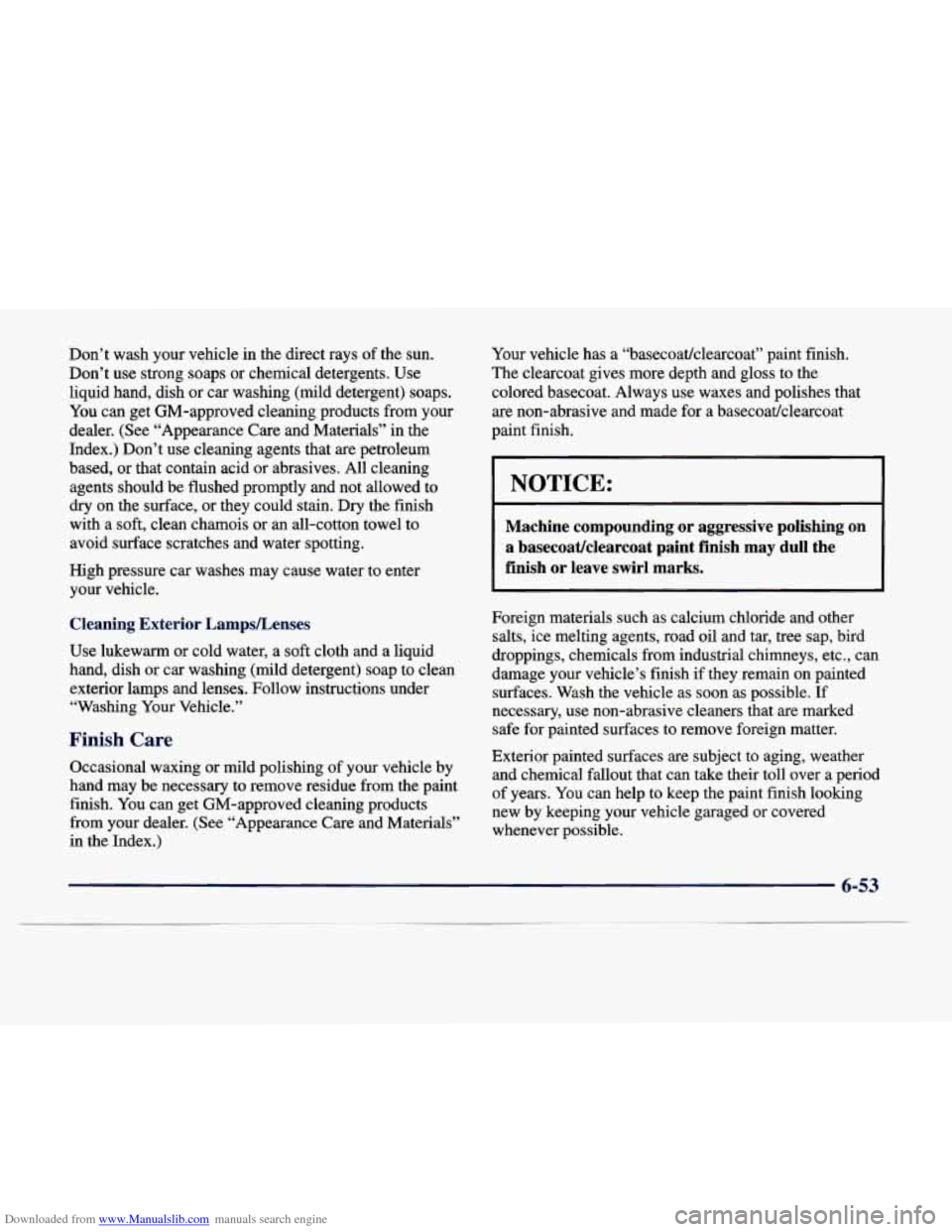
Downloaded from www.Manualslib.com manuals search engine Don’t wash your vehicle in the direct rays of the sun.
Don’t use strong soaps or chemical detergents. Use liquid hand, dish or car washing (mild detergent) soaps.
You can get GM-approved cleaning products from your
dealer. (See “Appearance Care and Materials” in the
Index.) Don’t use cleaning agents that
are petroleum
based, or that contain acid or abrasives. All cleaning
agents should be flushed promptly and not allowed to
dry
on the surface, or they could stain. Dry the finish
with a soft, clean chamois or an all-cotton towel to
avoid surface scratches and water spotting.
High pressure car washes may cause water to enter
your vehicle.
Cleaning Exterior LampsLenses
Use lukewarm or cold water, a soft cloth and a liquid
hand, dish or car washing (mild detergent) soap to clean
exterior lamps and lenses. Follow instructions under “Washing Your Vehicle.”
Finish Care
Occasional waxing or mild polishing of your vehicle by
hand may be necessary to remove residue from the paint
finish. You can get GM-approved cleaning products
from your dealer. (See “Appearance Care and Materials”
in the Index.) Your
vehicle has a “basecoatjclearcoat” paint finish.
The clearcoat gives more depth and gloss
to the
colored basecoat. Always use waxes and polishes that are non-abrasive
and made for a basecoatjclearcoat
paint finish.
NOTICE:
Machine compounding or aggressive polishing on
a basecoatlclearcoat paint finish may dull the
finish
or leave swirl marks.
Foreign materials such as calcium chloride and other
salts, ice melting agents, road oil and tar, tree sap, bird
droppings, chemicals from industrial chimneys, etc., can
damage your vehicle’s finish
if they remain on painted
surfaces. Wash the vehicle as soon as possible. If
necessary, use non-abrasive cleaners that are marked
safe for painted surfaces to remove foreign matter.
Exterior painted surfaces are subject to aging, weather and chemical fallout that can take their toll over a period
of years. You can help to keep the paint finish looking
new by keeping your vehicle garaged or covered whenever possible.
Page 341 of 386

Downloaded from www.Manualslib.com manuals search engine Cleaning Aluminum or Chrome
Wheels
(If Equipped)
Keep your wheels clean using a soft clean cloth with
mild soap and water. Rinse with clean water. After
rinsing thoroughly, dry with a soft clean towel.
A wax
may then be applied.
The surface of these wheels is similar to the painted
surface of your vehicle. Don’t use st?ong soaps,
chemicals, abrasive polishes, abrasive cleaners or
abrasive cleaning brushes on them because you could
darnage the surface. You may use chrome polish
on
chrome wheels, but avoid any painted surface of the
wheel, and buff
off immediately after application.
Don’t take your vehicle through an automatic car wash
that has silicon carbide tire cleaning brushes. These
brushes can also damage the surface of these wheels.
Cleaning Tires
To clean your tires, use a stiff brush with a tire cleaner.
I NOTICE:
When applying a tire dressing always take care
to wipe
off any overspray or splash from all
painted surfaces
on the body or wheels of the
vehicle. Petroleum-based products may damage
the paint finish.
Sheet Metal Damage
If your vehicle is damaged and requires sheet metal
repair or replacement, make sure the body repair shop
applies anti-corrosion material to the parts repaired or
replaced to restore corrosion protection.
6-54